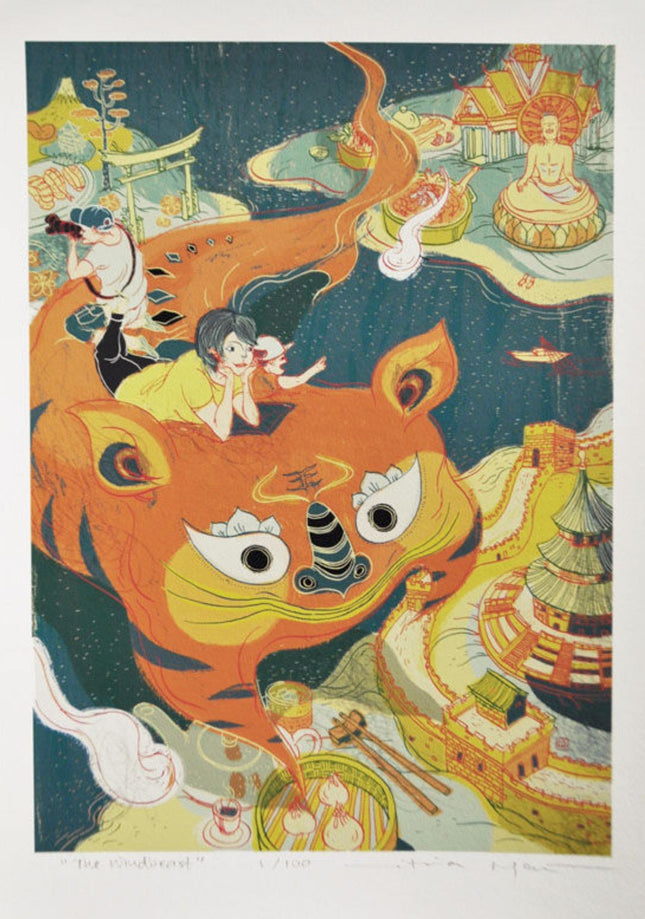
Dragon

Victo Ngai The Windbeast Giclee Print by Victo Ngai
The Windbeast Artwork Giclee Limited Edition Fine Art Print on 100% Cotton Hahnemühle Museum Etching Paper by Pop Culture Graffiti Artist Victo Ngai. 2014 Signed & Numbered Limited edition of 100 Artwork Size 13x19. Due to how this artwork was made and stored by the artist, many of Ngai's older prints contain slight yellowing to the extreme upper and lower white margin that extends about 1mm. This does not effect the image at all and the prints are perfect besides this. Victo Ngai's "The Windbeast" - A Confluence of Myth and Modernity "The Windbeast" by Victo Ngai, a striking piece of modern pop culture art, is a limited edition giclée print that is a vibrant testament to the fusion of traditional mythological themes with contemporary art styles. Created on 100% cotton Hahnemühle Museum Etching Paper, this artwork offers a lush texture that fits the rich narrative and visual complexity it presents. Victo Ngai, a renowned illustrator based in the United States, originally from Hong Kong, is celebrated for her intricate and thought-provoking illustrations that often incorporate elements of fantastical realism. Visual Symphony on Cotton Canvas In "The Windbeast," Ngai weaves an intricate tableau rich with cultural references and brimming with movement. The artwork, a cornucopia of vivid colors and whimsical imagery, features a central figure that could be interpreted as a mythical beast or a dragon — a nod to traditional Asian folklore. Swirling around this central figure are more miniature scenes and elements that seem to be at once a part of the creature and a separate narrative altogether. The use of 100% cotton Hahnemühle Museum Etching Paper heightens the piece's visual impact, as its fine grain and texture add depth and richness to the print that might be absent in other mediums. Ngai's choice of material is notable not only for its quality but also for its historical connection to the art world. Hahnemühle is one of the oldest papermakers in Europe, known for its high-quality art papers, and their Museum Etching Paper is designed specifically for artists who wish to reproduce their work with the same depth and detail as the original. By selecting such a distinguished canvas for her work, Ngai bridges the gap between digital illustration and traditional printmaking, underscoring the artistry in creating her work. "The Windbeast" in the Context of Street Pop Art and Graffiti While "The Windbeast" might be considered a departure from the raw, uncurated nature of street art and graffiti, its essence captures the spirit of these art forms. Street pop art and graffiti are characterized by their vibrancy, accessibility, and the way they often draw from various influences to make relevant statements to contemporary culture. Ngai's work aligns with these principles through its dynamic composition, engagement with folklore, and relevance to modern narratives of identity and globalization. The vivid, swirling colors and fantastical elements in "The Windbeast" resonate with street art's boldness and improvisational energy. The intricate details and narrative complexity parallel the layers of meaning often found in graffiti artwork, where each piece serves as a palimpsest of ideas and expressions. Ngai's print could easily be imagined as a large mural on the side of a building, engaging passersby with its otherworldly beauty and intricate storytelling. Conclusion: Victo Ngai's Artistic Fusion In sum, "The Windbeast" is a fine example of how traditional and modern elements can be synthesized to create timeless and contemporary art. Through her artwork, Victo Ngai contributes to the cultural dialogue, blending the mythical with the modern and the Eastern with the Western, creating pieces that reflect our multifaceted world. The limited edition nature of this print — with only 100 copies signed and numbered by the artist — adds an element of exclusivity that is often sought after in both the worlds of fine art and street art collectibles. This exclusivity, coupled with the artwork's rich narrative and visual appeal, makes "The Windbeast" a coveted piece for collectors and enthusiasts of modern pop culture, street pop, and graffiti artwork. It is a testament to Victo Ngai's prowess as an artist capable of capturing viewers' imagination, transporting them to worlds where myth and reality merge.
$290.00


